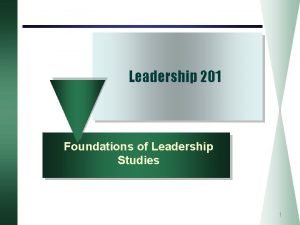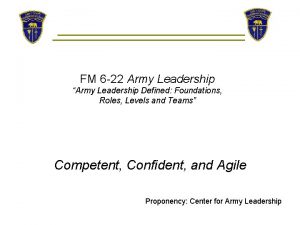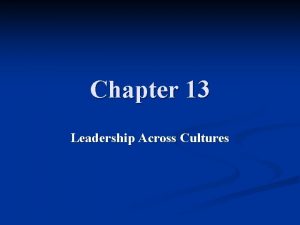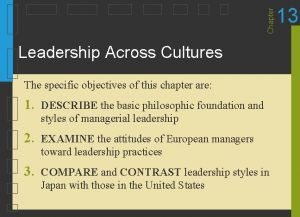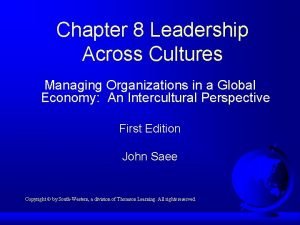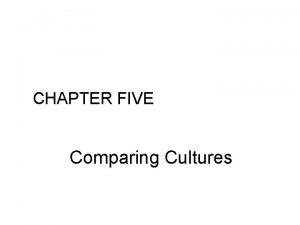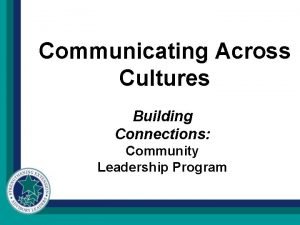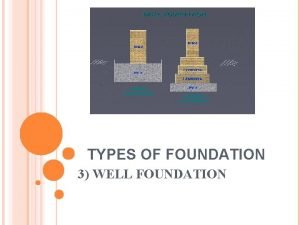Chapter 13 Leadership Across Cultures Foundation for Leadership




















- Slides: 20

Chapter 13 Leadership Across Cultures

Foundation for Leadership- Influencing people to direct their efforts toward the achievement of some particular goal (s) n http: //www. youtube. com/watch? v=Z 7 O 8 s 6 Ng Ack n What's the difference between a leader and a manager? n http: //www. youtube. com/watch? v=of. HFgh. Vh KQw n

Perceived Differences: Leaders vs. Managers n n n Table 13 -1 p. 457 Managers don’t perform the unique functions of leaders, consist of sheer responsibility, follow company objectives/rules to maintain stability as they react to inevitable change, and striving to always do things right Leaders guide/motivate team members, extremely visible, get the right people in the right positions, motivate them, money , matters become a secondary objective, proactive behavior, and to drive to ultimately do the right thing

Theories X, Y, and Z n n X Manager= one is lazy, coercion/threats of punishment must be used to get them to work Y Manager= under right conditions one works hard and seek increased responsibility/challenge Z Manager= believes workers seek opportunities to participate in management & are motivated by teamwork & responsibility sharing http: //www. youtube. com/watch? v=o. Or. Azvw. Hol. M

Leadership Behaviors & Styles Authoritarian- The use of work-centered behavior designed to ensure task accomplishment n Paternalistic- The use of work-centered behavior coupled with a protective employeecentered concern n Participative- The use of both work-or-taskcentered & people centered approaches to leading subordinates n

Leadership in the International Context European Managers use a highly participative leadership approach n French & Germans use a authoritarian approach n What is relevant with the study by Haire et al? n The leadership-related of the study determined mgrs were traditional (Theory X) or democratic-participative (Theory Y) n

4 Areas to Leadership per Haire et al. (Theory Y & X) 1) 2) 3) 4) Capacity for leadership & initiative Sharing information & objectives Participation Internal Control

Table 13 -3 p. 466 shows the Clusters of Countries in their study Anglo leaders tend to have MORE faith in the capacity of their people for leadership/initiative, they share info, objectives are important, more autocratic responses, and external rewards n http: //www. youtube. com/watch? v=3 Z 6 EKRD Mhl. A n

Leadership Approaches n n n Japanese Greater belief for subordinates for leadership/initiative, express attitudes toward the use of participation, share info/objectives, allow to actively participate in decisions n n n http: //www. youtube. com/watch? v =xt. MO 9 A-6 Fe 8 n China Individualism (Newer Generation)- Selfsufficiency/personal accomplishments Collectivism (Current Generation) - Willingness to subordinate personal goals to those of the work group w/an emphasis on sharing /group harmony Confucianism (Older)- Assigned to societal harmony, virtuous behavior, personal. /interpersonal harmony

Leadership in… n n Middle East Have higher attitude scores for capacity for leadership/initiative, highly educated, and participative leadership n n India More productive when managers took a high people/high task approach (participative), focus on the individual, bound by old traditions http: //www. youtube. com/wa tch? v=28 Fu. Kwcn 35 M http: //www. youtube. com/wa tch? v=te 7 Jkd. UZh. IY

Leadership in Latin America Mexico- Authoritarian and Participative, mgrs who welcome input from subordinates viewed as weak/incompetent, moving to modern style leader n Chile, Argentina, Bolivia- Authoritarian n

Facts…in North Korea n http: //shine. yahoo. com/fashion-beauty/northkorea-s-hottest-hairstyles-are-not-reallyoptional-210017315. html

Men too…

3 Leadership Types n n http: //www. youtube. com/watch? v=60 O 2 OH 7 m. Hys Transformational- Visionary agents with a sense of mission & who are capable of motivating their followers to accept new goals & new ways of doing things Transactional- One who exchanges rewards for effort & performance & work on a “something for something” basis Charismatic- One who inspires/motivates EE’s through their traits/abilities

Most effective leader is… Transformational with characterized with the 4 I’s n Idealized Influence n Inspirational Motivation n Intellectual Stimulation n Individualism Consideration n

Qualities for Successful Leaders Table 13 -6 p. 476 n Advertisements in newspapers for leadership qualities n n http: //www. youtube. com/watch? v=q. PNIZo. Nk Sk. Y

Culture Clusters & Leader Effectiveness Table 13 -7 p. 477 n Rankings of Leadership Attributes n Affective Cultures- leaders tend to exhibit their emotions n Neutral Cultures- leaders do not tend to show their emotions n

Table 13 -8 p. 479 Affective vs. Neutral Cultures when… n Managing or Being Managed n Doing Business with Individuals n n Recognize the way in which people behave in either culture

Types of Other Leaderships Authenticn They posses positive psychological aspects as confidence/optimism, positive morals to guide them, lead by example and performs above expected standards n It’s becoming MORE important in the global marketed world, due to it creates a better understanding n

Types of Other Leaderships Ethicaln Provides the philosophical basis for responsible business practices n Responsiblen Values based leadership, ethical decisionmaking, quality stakeholder relationships n Servantn Achieving results by giving priority attention to the needs of their colleagues & those they serve n
 Spiritual organization
Spiritual organization Recreational activities across cultures and genders
Recreational activities across cultures and genders Communicating across cultures ppt
Communicating across cultures ppt Body language across cultures respuestas
Body language across cultures respuestas Motivation in different cultures
Motivation in different cultures Motivation across cultures
Motivation across cultures Motivation across cultures
Motivation across cultures Chapter 20:1 operating the microscope
Chapter 20:1 operating the microscope Chapter 5 a clash of cultures
Chapter 5 a clash of cultures Cultures of the mountains and the sea
Cultures of the mountains and the sea Chapter 13 section 1 cultures clash on the prairie
Chapter 13 section 1 cultures clash on the prairie The collision of cultures chapter 1
The collision of cultures chapter 1 Pad foundation
Pad foundation Composition of urine slideshare
Composition of urine slideshare Leadership across culture
Leadership across culture Arizona leadership foundation
Arizona leadership foundation Global leadership foundation emotional intelligence test
Global leadership foundation emotional intelligence test Contingency theory strengths and weaknesses
Contingency theory strengths and weaknesses Army leadership definition
Army leadership definition Formuö
Formuö Novell typiska drag
Novell typiska drag

















